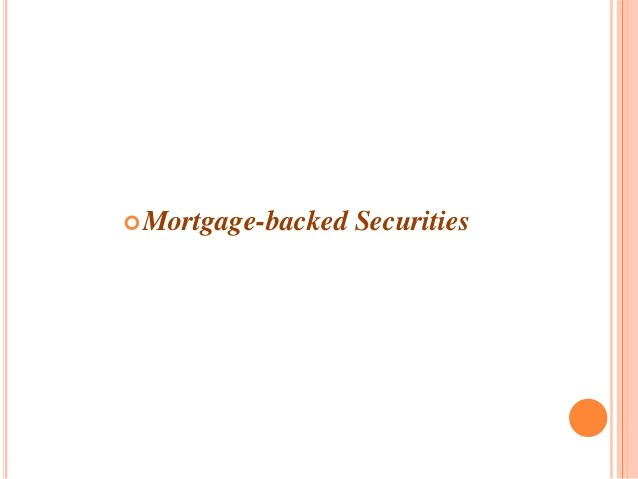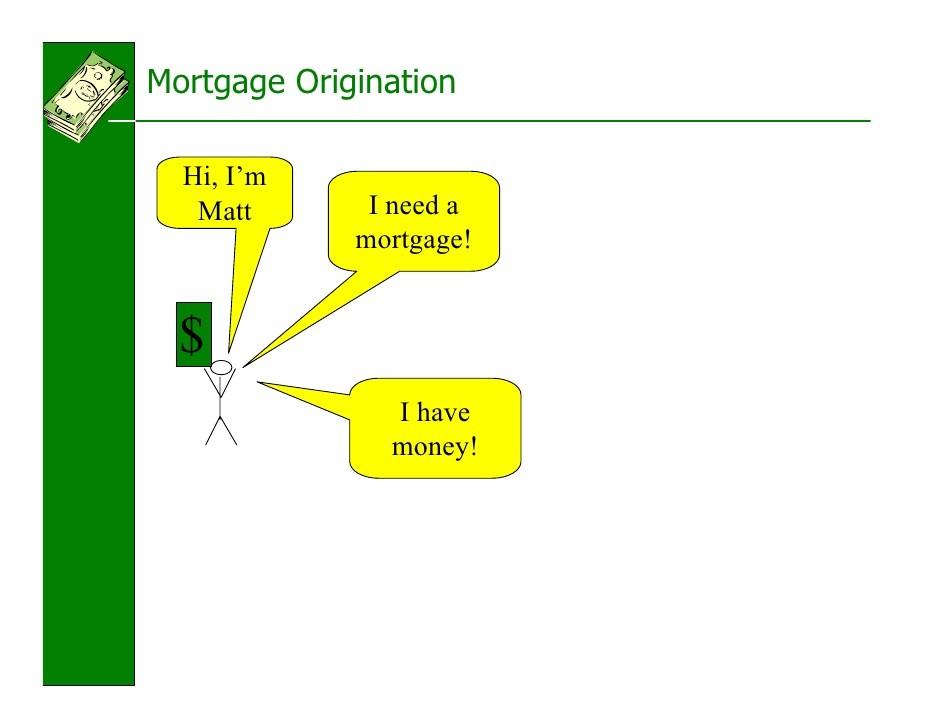Mortgage Backed Securities_2
Post on: 13 Август, 2015 No Comment

Related Content
Note: Mortgages are generally packaged and sold as bonds, called mortgage backed securities. So watching bond yields gives a good indication of the direction of mortgage rates.
A mortgage-backed security (MBS) is a security that is based on a pool of underlying mortgages. MBS are usually based on mortgages that are guaranteed by a government agency for payment of principal and a guarantee of timely payment. The analysis of MBS concentrates on the nature of the underlying payment stream, particularly the prepayments of principal prior to maturity.
Before the development of the mortgage-backed securities market in the early 1980s, each residential mortgage underwritten was a unique transaction. Joe Q. Public would walk into his bank or trust company and enter into a mortgage. Say Joe chooses Lack Trust Company. Joe enters into a mortgage on a specific real estate property, 100 Easy Street in the Hills of Richmond, with the good people of Lack Trust. Sounds easy. But think of what has to happen for this mortgage to be underwritten. Lack Trust must check Joe’s credit (salary, assets etc.) and establish the worth of the property through an appraisal. Joe and Lack Trust then negotiate and establish the terms. This includes the amount and interest rate of the mortgage, the amortization of principal as well prepayment terms. Lack Trust then has to hire a lawyer to register the mortgage against the property with a property registry office.
It can easily be seen that Joe’s mortgage is an unique thing. There are no other mortgages on 100 Easy Street with Joe as the borrower on those terms and conditions. That is why most mortgages were held by the financial company that originated them. Trading was awkward, as the mortgages had to each be evaluated and administered differently. The originating organization usually kept the servicing and were loath to part with their mortgages. Only very large institutional investors participated in the market. Smaller investors didn’t have the expertise to evaluate the mortgages or a large enough portfolio to properly diversify. If a single mortgage was in the $200,000 range, a maximum 10% position would require a total portfolio of over $2,000,000 to be properly diversified. Therefore, for an individual investor, if their portfolio was to be properly diversified, a mortgage was an awkward asset to own.
By grouping a large number of mortgages together in a pool, the uniqueness of each mortgage is submerged in the whole. Let’s take 500 mortgages at $200,000. This gives us a pool of $100 million of mortgages. We can take the aggregated statistics such the weighted average maturity (WAM) or the remaining amortization (RAM) and use these to describe the pool. We can then make sure no mortgage is too large a portion of the pool. Arrangements are made such that the servicing agent collects the mortgage payments and gives them to central paying agent which, in turn, passes through the payments to the final investor. We now have something that looks very much like a bond. However, we do have a problem: how do we assess each of the mortgages for their creditworthiness?
Enter mortgage insurance. Mortgage insurance guarantees the principal of a mortgage against default by the borrower. This process provides investors with a commoditized credit risk. The large mortgage insurers in the United States and Canada are government or quasi-government agencies. These agencies use the credit standing of their respective national governments to guarantee mortgage loans. In Canada, the Central Housing and Mortgage Corporation (CHMC) guarantees mortgages for different programs backed by its borrowing power under federal government legislation, the National Housing Act (NHA). Investors could then view the credit risk on the principal amount as equivalent to the credit risk of Canadian government bond.
Investors were still wary of the timely payment issue, since the process of collecting on a defaulted loan was a lengthy affair. In the 1980s, some investors in NHA mortgages in Canada were unable to collect on their defaulted mortgages from the CHMC for several years. This meant they lost the use of their money and the interest it could earn for a lengthy period, although they eventually collected their principal and accrued interest. The Canadian MBS program remedied this by adding a guarantee of timely payment in 1987. This guarantee of principal and timely payment meant that the credit risk was removed from the equation. With a defaulted mortgage, the payments would be kept up until the principal amount was repaid by the guarantor, CMHC.
The removal of credit risk does not mean that MBS are without risk. There is a major risk inherent in the cash flows called prepayment risk. Let’s say that Joe was unusually frugal and decided to pay off his mortgage early. All his neighbors, who also were in the same pool (we did not obviously diversify geographically) decide to follow suit. We, the investors, are sitting pretty. We know we’re safe credit wise for the next five years. But when Joe and his neighbors walk in the door of Lack Trust, our portfolio starts to shudder. Their combined frugality means that we get our principal back early. Not bad, but to the investors it also depends on what interest rates have done since the pool was issued.
Let’s say we bought the pool when interest rates were high in early 1994. We have a pool with a coupon of almost 9%. Two years later, we have interest rates for the remaining three year term at somewhere around 5%. Oh, oh. We thought we would get 9% for five years, yet two years into the term we are forced to reinvest at 5%. That means we lose 4% for three years. OUCH! Even if there are a few stalwarts who decide not to pay their mortgage off, nobody is going to want to buy something at $112 that could be paid off at any time. Therefore, the price falls to the point where the market thinks its being compensated for the prepayment risk (which is going to be not too far above par). Whether we are paid out early or not, we are going to take a bath on this one. We would have done much better to put our money in a normal bond that did not prepay.
Now consider whether or not we should buy the pool in the current low interest rate environment. By religiously reading the bond articles on our favorite internet site we have learned about reinvestment risk, prepayment risk and the effect of interest rate changes on bond values. We have stayed fully invested in long-term bonds until now (December 1996) but have now decided to become defensive as we think rates will rise. Now assume, going forward a year, we are right (this only happens on the Internet). The economy surges. Inflation and interest rates surge. Central bankers fling themselves into Jacuzzis in fits of despair. How have our MBS done considering Joe and his neighbors have decided to pay off their mortgages after two years (their houses have doubled in price and they’re trading up)?
Think of it. Dream of it. Interest rates are back to 9%. Our pool carries an average mortgage rate of 5% and coupon nearly the same. When Joe and his frugality bunch pay us out, we sign up for Club Med, despite the impending recession of 1998. We get $100 of principal invested at 5% returned to us to invest at 9%. Even if some of the pool doesn’t prepay, the rise in interest rates has knocked the value of the MBS down as interest rates have risen. Our $100 invested is now worth less than $90. Except that everyone recognizes that any prepayments will be at $100 and all pools tend to prepay something. People move, default and even are frugal and prepay their mortgage even though it does not make economic sense. The MBS will do much better than a normal bond that doesn’t prepay.
IT’S THE PREPAYMENT RISK. You won’t hear much about prepayments from your favorite salesperson, but its the only thing that counts with MBS. A good trick is to watch out for the words after analysis. This means that a certain prepayment experience has been assumed in calculating the yield. A smart analyst takes this with a chunk of rock salt and concentrates on the pool characteristics and prepayment experience of similar pools and issuers. She then tries out a few scenarios to see how things will go with varying interest rates and prepayment conditions. The trick is establishing the future payment stream and pricing it.

If you think interest rates are going to fall, avoid prepayable MBS. If you think they are going to rise, MBS might not be a bad investment. If you don’t think you have an insight into interest rates, don’t buy prepayable or open MBS. Try closed MBS or normal bonds. And remember your mantra: it’s the prepayment risk, stupid.
Additional Information — ways to invest in MBS
These are debt obligations backed by a pool of mortgages. They usually have a pass through feature. Ginnie Mae’s are the most popular type of this security. Investors have an ‘undivided’ interest in the pool. The investor doesn’t own any particular mortgage. Rather, he has a proportionate interest in the cash flow generated by the entire pool. When we talk about a pass through feature, we mean that multi-payments of interest, principal, and sometimes pre-payment of mortgages, are passed through to the investor. Ginnie Mae’s (Government National Mortgage Association) are comprised of VA guaranteed loans or FHA insured mortgages and are backed by the full faith and credit of the U.S. Government. Payments are received monthly by the investor.
Freddie Mac’s (Federal Home Mortgage Corporation) are another type of pass through. Freddie Mac’s are ‘Participation Certificates or PC’s. These are comprised of FHOMC conventional mortgages on single family homes. Freddie Mac’s are not guaranteed by the full faith and credit of the U.S. Government. Therefore, the yield of Freddie Mac’s is a little better than Ginnie Mae’s.
Fannie Mae’s (FNMA) are similar to Freddie Mac’s in that they are both participation certificates. Fannie Mae’s consist of some conventional mortgages and FHA insured mortgages. Fannie Mae’s are not guaranteed by the full faith and credit of the U.S. Government. However, it is unlikely that the government would permit them to default. The yields on Fannie Mae’s are slightly better than Ginnie Mae’s.
Collateralized Mortgage Obligations (CMO) are bonds that are collateralized by mortgages or mortgage backed securities. Unlike a traditional pass through, like we discussed above, a CMO has a stated maturity. There are short term, intermediate term, and long term, CMO’s. Most of the mortgages are traditional mortgages which are not VA or FHA mortgages. As the principal on the mortgages is being paid off, it is used exclusively for the newest maturity in sequence until each maturity has been paid off.
Real Estate Mortgage Investment Conduits (REMIC’s) is an entity that holds a fixed pool of mortgages and issues multiple classes of interests in itself to investors. The classes of interest are called ‘Regular Interests’ and ‘Residual Interests’. A regular interest has terms which are fixed when the REMIC starts. This type of interest unconditionally entitles the investor to receive a specified principal amount. This particular interest can be issued in either debt or stock. A ‘Residual Interest’ is another interest which is not a regular interest. This creates a structure similar to preferred stock and common stock. The residual interest has variable interest similar to common stock. For Federal Tax purposes, all regular interests, regardless of whether they are debt or equity instruments, are treated as debt instruments. Therefore, payments that flow through are regarded as interest. For residual interests, the payments that flow through are treated as ordinary income.














